
32
You may have additional accessories and options, such as an awning on
the door side which need to be opened. Separate instructions are
provided by the manufacturer of these components.
General Detector Information
As you are confined in a RV, which is much smaller than a standard
house, you must realize safety detectors will be activated much sooner
than in a residential house, due to there being less air and oxygen
volume. Each of these detectors have their own manual and instructions,
providing additional information for its care and operation. Lifetime of
each detector is up to 10 years and will need to be replaced as per
manufacturer’s instructions. Record purchase date on the detector.
Safety Detectors
Fire Extinguisher
A fire extinguisher is installed in each vehicle and is located near the
entrance door. Be familiar with its location and operating instructions as
printed on the extinguisher. Inspect your extinguisher at least two times
per year or more often, as instructed on the extinguisher. Extinguisher is
rated at 5 or 10 B.C.
Propane / Carbon Monoxide Detector
Any recreational vehicle which contains a propane fuel system with
propane consuming appliances requires a propane leak detection device
for safety protection. Currently, this detector also serves as a carbon
monoxide detector, as a combination protection device. A converter or
auxiliary battery is required to supply 12-volt DC energy to operate the
detector. There is no master cut-off switch or in-line fuse to disengage
detector, only 15 amp fuse in fuse panel.
What Is Carbon Monoxide?
Carbon Monoxide (CO) is a highly poisonous gas which is released when
fuels are burned. It is invisible, has no smell and is therefore very difficult
to detect with the human senses. Under normal conditions, in a room
where fuel burning appliances are well maintained and correctly
ventilated, the amount of carbon monoxide released into the room by
appliances is not dangerous. Fuels which emit CO are wood, coal,
charcoal, oil and petroleum products, which MUST have exhaust vents.
Such gases can built up in the blood, interfering with the body’s ability to
supply oxygen to itself.
Because CO is a colorless, odorless, tasteless, and highly poisonous gas
that prevents the blood from carrying oxygen to vital organs, CO is 200
When preparing to depart or move, don’t forget to reverse the
procedures above. Remember, open roof vents and windows
are subject to wind damage in transit.















































